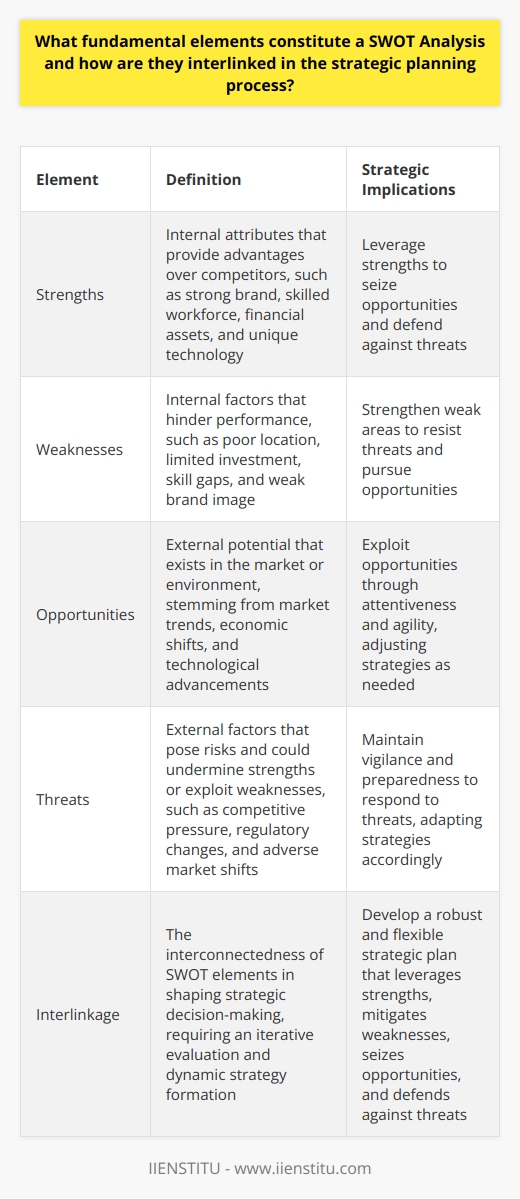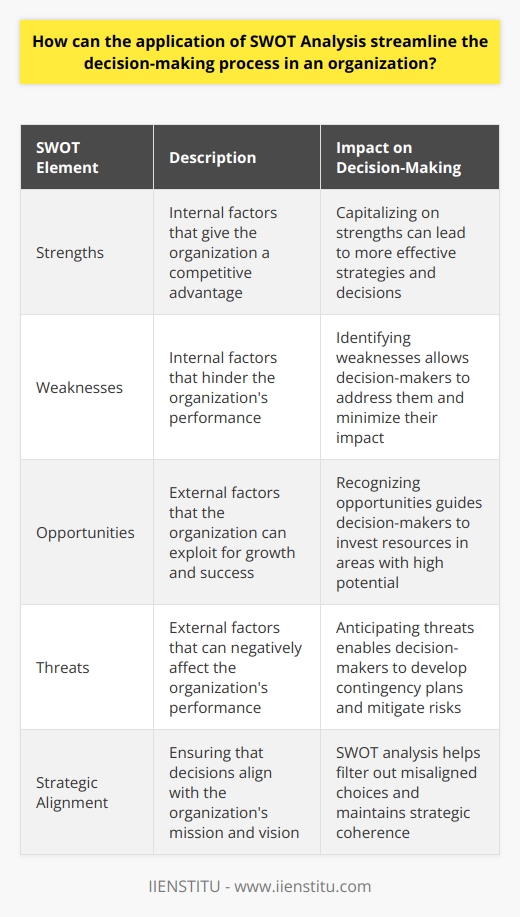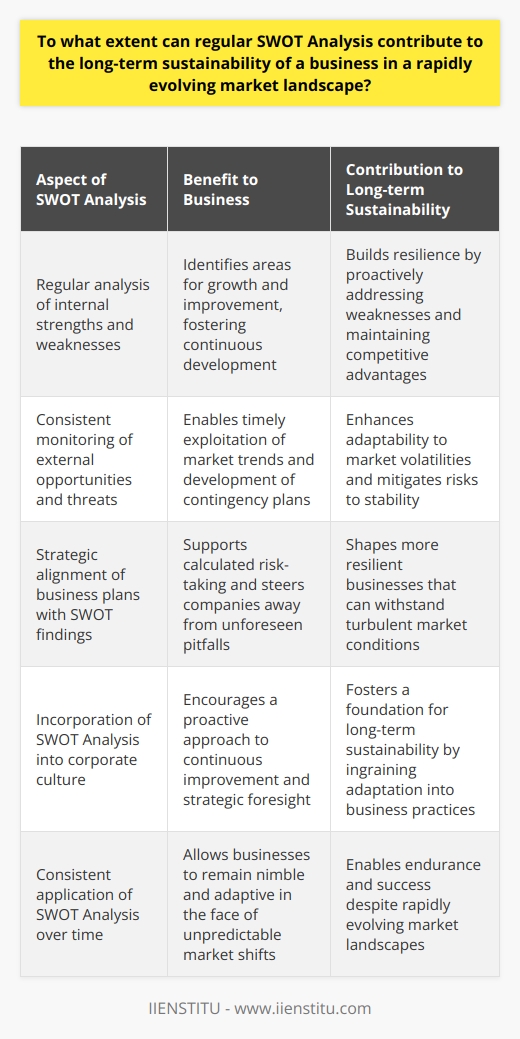
The essence of business success lies deeply within the framework of strategic decision-making. In a world where competition is rife and the business environment is constantly fluctuating, organizations must adapt to survive and thrive.
This is where SWOT analysis stands out as an indispensable tool. By offering a clear and methodical approach, it helps businesses leverage their internal capabilities while confronting external challenges. With robust analytical underpinnings, SWOT Analysis is a tool that allows businesses to craft strategies that are not just sound, but also responsive to the ever-changing market dynamics.
Introduction to SWOT Analysis
Definition of SWOT Analysis: Strengths, Weaknesses, Opportunities, and Threats
SWOT Analysis is an evaluative framework that stands for Strengths, Weaknesses, Opportunities, and Threats. It enables organizations to construct a comprehensively structured snapshot of their competitive position within the marketplace. By dissecting an organization's internal and external environments, SWOT encourages a nuanced assessment to formulate strategic initiatives. The categorization into strengths, weaknesses, opportunities, and threats offers a versatile yet straightforward method to analyze complex business situations.
Brief overview of the concept and importance
The application of SWOT Analysis traverses a range of strategic planning processes. It holds immense importance because it can reveal critical insights that may not surface through other evaluative methods. Moreover, it directionally steers companies by shedding light on unique differentiation points and potential growth avenues. Businesses negating the utility of such analysis may overlook latent factors that could impede their success or fail to capitalize on market opportunities.
Explanation of why businesses need to conduct SWOT analyses
Businesses operating in dynamic environments need to conduct SWOT analyses to respond effectively to changes and to gain a strategic edge. Assessing internal strengths and weaknesses provides a firm with the self-awareness necessary to capitalize on its competitive advantages. Similarly, acknowledging external opportunities and threats is pivotal for strategic positioning and long-term success. The value derived from these insights can be further augmented when integrated into a problem solving course free or an online certificate course, offering an educational foundation for strategic decision-making.
Understanding the Four Components of SWOT Analysis
Strengths in SWOT Analysis
Strengths are internal attributes that give an organization an advantage over competitors. In the context of SWOT Analysis, comprehending and evaluating these strengths means recognizing resources, skills, or other advantages that provide the business with a distinctive market proposition. These could range from a strong brand reputation, a loyal customer base, to proprietary technology or intellectual property. Identifying these elements is the first step in leveraging them to achieve strategic goals.
How to identify and assess internal positives
To unearth a business's core strengths, one must delve deep into what sets the company apart. This involves a comprehensive review of the organization's processes, resources, and employee capabilities, often extracting this information through interviews, surveys, and performance data. Tapping into these unique attributes means a company can more accurately align its strategy to benefit from these internal positives.
Real-life examples of strengths in a SWOT Analysis
Consider, for example, a technology firm with a dedicated R&D department which has developed cutting-edge software ahead of the market curve. This innovation, a clear internal strength, can be highlighted in its SWOT Analysis and utilized to carve out a larger market share in strategic planning. Another example could be a retailer with exceptional customer service, fostering strong customer loyalty, which sets it apart from competitors.
Weaknesses in SWOT Analysis
Weaknesses refer to the internal elements that may place the business at a disadvantage relative to competitors. These are areas where the organization could improve to match or outperform its competition. Weaknesses can encompass inadequate research and development, limited financial resources, or a weak brand image. Recognizing these factors is critical for a company to address them directly.
The significance of recognizing internal negatives
Identifying weaknesses is as crucial as identifying strengths, for it lays the groundwork for mitigating potential setbacks before they manifest as significant difficulties. By acknowledging the internal challenges, a company can take proactive measures to bolster its less developed areas or strategically plan to navigate around these shortcomings.
Illustrative examples of weaknesses in an analysis
A manufacturing company may find, upon a SWOT Analysis, that it has an aging production line that's less efficient than its contemporaries, impacting its market competitiveness. Another instance could be a service-based enterprise that lacks a robust online presence, a glaring weakness in an increasingly digital world.
Opportunities in SWOT Analysis
Opportunities are external possibilities that the organization can exploit to its advantage. These prospects for improvement or growth emerge from trends, changes in the marketplace, or shifts in consumer behavior. Recognizing and evaluating such opportunities are central to an organization seeking to expand or diversify its operations.
How to recognize potential external positives
Recognizing opportunities often requires businesses to look beyond their immediate operational boundaries and to scan the external environment methodically. This could involve analyzing market trends, staying informed about technological advancements, or understanding shifts in consumer demands. Remaining vigilant and forward-thinking helps to identify valuable opportunities that an organization can capitalize on.
Examples of opportunities identified in past analyses
For instance, a beverage company might identify a growing consumer trend towards healthier drink options as an opportunity. By adapting its product line to include low-sugar or sugar-free alternatives, the company can meet new market demands and potentially increase its market share. Another example may be a service provider acknowledging the rising importance of mobile platforms, and thus investing in mobile app development to capture the growing segment of consumers using smartphones for services.
Threats in SWOT Analysis
Threats are external challenges or obstacles that could potentially harm an organization's performance or strategic goals. These are the factors beyond the control of the organization but must be taken into account for comprehensive planning. They can take various forms, including new competitors, economic downturns, and changing regulatory landscapes.
The necessity of acknowledging potential external negatives
Acknowledging potential threats is not about fostering a sense of fear but about being pragmatically prepared. By actively identifying and assessing threats, businesses can develop contingency plans, diversify their risk, and remain resilient in the face of adversity. It empowers organizations to anticipate changes and to react in a calculated manner.
Clear examples to portray threats in an analysis
As an example, a locally dominant retailer might list the expansion of international e-commerce giants into their market as a significant threat, requiring strategies to solidify customer loyalty and service differentiation. Another could be a pharmaceutical company that must consider the expiration of patents on its leading products as a threat, with generic manufacturers ready to enter the market.
Steps to Conducting a Successful SWOT Analysis
Preparation needed for a SWOT Analysis
To conduct a successful SWOT Analysis requires adequate preparation, beginning with a clear understanding of the objectives of the analysis and ensuring all relevant stakeholders are involved. This preparation phase should include data collection from various sources within the organization, such as financial reports, customer feedback, and employee surveys, to provide a foundation for the analysis.
Detailed step-by-step process of carrying out an analysis
The process of carrying out a SWOT Analysis starts with the division of a team into smaller groups to tackle each component separately. Each group should brainstorm and document elements related to their assigned area, be it strengths, weaknesses, opportunities, and threats. This process requires honesty and objectivity from all participants. Following the brainstorming sessions, the groups come together to consolidate their findings and to discuss potential overlaps and intersections between the four categories.
Tips and strategies to ensure a thorough and effective SWOT Analysis
To ensure the analysis is thorough and effective, it's important to facilitate open communication among all participants and to guide the discussions towards pragmatic and actionable insights. A diverse team can provide a wide range of perspectives, thus enriching the analysis. Additionally, ensuring the SWOT Analysis remains focused on specific objectives rather than becoming a generic discussion is crucial. Utilizing insights from the SWOT analysis can be further enhanced by incorporating them into strategic plans or an online certificate course that focuses on strategic management and decision making.
Utilizing SWOT Analysis for Strategic Planning
How to translate the outcomes of a SWOT Analysis into actionable strategies
The true utility of a SWOT Analysis is realized when its results are translated into actionable strategies. This translation process involves prioritizing the identified elements according to their strategic importance and potential impact. Typically, strategies are designed to build on strengths, address weaknesses, capitalize on opportunities, and mitigate threats. The integration of these strategies into the organization's wider strategic plans enables a targeted and nuanced approach to achieving business objectives.
Importance of using SWOT Analysis in company's strategic planning
Incorporating SWOT Analysis into a company's strategic planning is essential for maintaining a proactive approach to business strategy. It ensures that a business not only plays to its strengths and improves on its weaknesses but also remains agile enough to seize external opportunities and guard against potential threats. Regularly conducted SWOT analyses encourage continuous reassessment and adaptation to the changing business landscape.
Real-world examples showing successful application of SWOT results
Numerous companies across different industries have demonstrated the value of deploying SWOT Analysis results in their strategic planning. For example, a leading coffee chain may use its SWOT outcomes to focus on expanding in markets with a growing café culture (opportunity), while also addressing a weakness such as a lack of diversified food options. Likewise, a tech company facing strong competition (threat) could strategize to leverage its unique user-friendly software interface (strength) to differentiate itself in the marketplace.
SWOT Analysis is more than a mere business tool; it is a strategic compass that guides firms through the turbulent waters of market dynamics.
The importance and benefits of conducting regular SWOT Analyses cannot be overstated—they serve as a basis for informed decision-making, helping businesses to navigate their landscape more effectively. Strategic foresight, combined with a knowledge of one's intrinsic capabilities and external possibilities, can carve out a path for continual improvement and success. As such, businesses, be they nascent or established, are encouraged to regularly employ SWOT Analyses to remain competitive and to chart a course for long-term prosperity. This echoes the necessity for strategic vigilance and the indispensable value of continuous learning, whether through practical business engagements or educational enrichment such as a problem solving course free of barriers to access. In sum, SWOT Analysis is not just an evaluative measure—it is a strategic imperative.
Frequently Asked Questions
What fundamental elements constitute a SWOT Analysis and how are they interlinked in the strategic planning process?
SWOT Analysis Fundamentals
SWOT Analysis stands for Strengths, Weaknesses, Opportunities, and Threats. It serves as a cornerstone in strategic planning. This tool enables businesses to align internal strengths and weaknesses with external opportunities and threats. Here, we dissect each component.
Strengths
Strengths are internal attributes. They provide advantages over competitors. Identifying strengths involves introspection. Recognize positive tangible and intangible attributes. Consider resources, capabilities, and processes. Acknowledge strong brand, skilled workforce, financial assets, and unique technology. These elements create a solid foundation.
Weaknesses
Weaknesses are also internal factors. They hinder performance. Realization of weaknesses demands candor. Acknowledge shortcomings in resources and capabilities. Reflect on areas like poor location, limited investment, skill gaps, and weak brand image. Understanding weaknesses allows for corrective action.
Opportunities
Opportunities reflect the external potential. They exist in the market or environment. They present pathways for growth and improvement. Opportunities may stem from market trends, economic shifts, and technological advancements. Exploiting these requires attentiveness and agility.
Threats
Threats are external factors that pose risks. They could undermine strengths and exploit weaknesses. Common threats include competitive pressure, regulatory changes, and adverse market shifts. Vigilance and preparedness define the response to threats.
Interlinkage in Strategic Planning
SWOT analysis interlinks intricately with strategic planning. It helps organizations craft strategies. These strategies leverage strengths and opportunities. They also mitigate weaknesses and threats. The interplay shapes decision-making.
Internal versus External
Strengths and weaknesses lie within the company's control. Opportunities and threats do not. Distinguish between them for relevant strategies.
Reality versus Possibility
Acknowledge current circumstances with strengths and weaknesses. Look toward the future with opportunities and threats. Balance is essential.
Leverage and Defense
Use strengths to seize opportunities. Also, apply them to fend off threats. Strengthen weak areas to resist threats. Adjust strategies to pursue opportunities.
Dynamic Strategy Formation
Monitor the SWOT elements continuously. Adapt strategies as circumstances evolve. Keep strategies responsive and proactive.
In summary, understanding the fundamental elements of SWOT Analysis and how they interconnect ensures effective strategic planning. The process requires an iterative evaluation. The result is a strategic plan that is both robust and flexible. The plan equips the organization to navigate a competitive and ever-changing business landscape.

How can the application of SWOT Analysis streamline the decision-making process in an organization?
The Essence of SWOT in Decision-Making
Organizations face dynamic environments. They must adapt to survive and thrive. This need breeds complex decisions. Decision-makers hence require robust tools. Here, SWOT analysis offers a beacon.
SWOT: A Brief Overview
SWOT stands for Strengths, Weaknesses, Opportunities, and Threats. It prompts an introspective and external assessment. It is both versatile and straightforward. This analysis works for various organizational sizes and types.
Importance in Streamlined Decision-Making
SWOT guides focus. It highlights critical internal and external factors. Decision-makers then concentrate on pivotal issues. Redundant considerations drop off. This makes the decision process more efficient.
It promotes a comprehensive view. By observing strengths, weaknesses, opportunities, and threats, it counters narrow perspectives. Each element requires attention. Leaders must balance these factors strategically.
It drives strategic alignment. Decisions must align with the organization's mission and vision. SWOT ensures that decisions contribute to these goals. It filters out misaligned choices.
SWOT encourages forward thinking. Opportunities and threats look to the horizon. They demand evaluation of future scenarios. This anticipative approach positions the organization proactively.
It fosters collaboration. Each department can contribute to the SWOT analysis. This inclusion fosters unity. It ensures diverse inputs in decision-making. This leads to well-rounded conclusions.
Application in Streamlined Decision-Making
Identify core competencies
Recognize limitations
Spot market trends
Assess competitive landscape
Evaluate risk factors
Organizations can deconstruct complex situations using SWOT. They dissect issues into manageable portions. The analysis acts as a decision-making funnel. It directs attention to areas of highest leverage.
Decision speed sees an uptick. With a SWOT framework, choices emerge more readily. The framework acts as a sieve. It filters actionable intelligence from noise. This results in rapid, yet informed, decision-making.
Strategies emerge directly from the analysis. It answers what to capitalize on and what to mitigate. It devises clear action points. These can be integrated into business plans and executive agendas.
SWOT analysis serves as a critical tool. It fine-tunes the decision-making process. It ensures relevance and strategic coherence. It encourages collaboration and primes an organization for future challenges.
Each application of SWOT makes the next one more effective. This practice ingrains strategic thought throughout the organization. It fosters a culture of intentional and informed decision-making.

To what extent can regular SWOT Analysis contribute to the long-term sustainability of a business in a rapidly evolving market landscape?
SWOT Analysis and Business Sustainability
Understanding SWOT Analysis
SWOT Analysis stands as a fundamental tool. Firms grasp internal and external factors through it. Strengths and weaknesses lie within. Opportunities and threats dwell outside. Recognition of these factors drives strategic planning.
Regular SWOT for Market Adaptation
Markets shift, often unpredictably. Regular SWOT Analysis aids in anticipating changes. It makes businesses nimble and adaptive. Strengths can evolve; weaknesses may diminish. New opportunities emerge; threats may escalate.
Strengthening Internal Capabilities
Strengths foster competitive advantage. Regular analysis helps maintain these advantages. It also identifies areas for growth. This proactive approach encourages continuous improvement.
Weaknesses, when neglected, impede progress. Regular analysis turns weaknesses into improvement plans. It prevents complacency in business operations.
Seizing External Opportunities
Opportunities are potential pathways to success. Regular SWOT keeps firms alert to these. It aids in aligning strategies with market trends. Timely exploitation of opportunities enhances market position.
Mitigating External Threats
Threats pose risks to stability. Ignoring these can lead to decline. Regular SWOT ensures vigilance against threats. Firms develop contingency plans early. This foresight defends against market volatilities.
Implementing SWOT for Long-term Success
Identify strategic priorities frequently
Align goals with market dynamics
Adjust resource allocation promptly
Foster a culture of agility and adaptability
Regular SWOT contributes to calculated risks. It steers companies away from unforeseen pitfalls. This strategic tool shapes more resilient businesses.
Consistent SWOT Analysis supports strategic foresight. It builds a foundation for long-term sustainability. Adaptation becomes ingrained in corporate culture. Thus, a business endures despite a turbulent market.



